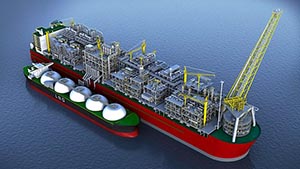
The Australian based gas exporters (part 2)
As we discussed in a post last month, it is unlikely that there will be any new Australian offshore “greenfield” LNG projects, except for floating LNG facilities.
Floating LNG facilities are a new technology, and are expected to drive 35 per cent to 50 per cent life of field cost savings. These are to be introduced at Shell’s 3.6 million tonne per annum (mtpa) Prelude field and Petronas’ 1.2 mtpa Kanowit, Malaysian field from 2016-17.
There are no platforms, pipelines, shore-based liquefaction and storage facilities, roads, jetties or dredging requirements. That’s fewer jobs for Australians.
The Prelude floating LNG facility is 488 metres long, 74 metres wide, weighs 600,000 tonnes fully loaded, will have 2000 kilometres of pipework and 220,000 kilometres of cabling and will cost US$12 billion. Floated from Samsung Heavy Industries’ operation at Geoje Island in South Korea, the mooring system will allow the barge to hang off four cables anchored via piles to the sea floor. The gas, chilled at -162 degrees Celsius, shrinks through the liquefaction process 600 times.
It is logical that other projects, such as Browse field, which has a common (part) owner in Shell, and has more than five times the reserves of Prelude, will take advantage of the 1.6 billion man hours that have gone into the floating LNG design.
As the floating LNG technology expands over the long term to service the 140 trillion cubic feet of Australian stranded gas (according to CSIRO), it is likely the Australian resource service companies will be somewhat bypassed for the massive Korean builders and their sub-contractors.
The Australian government, however, should do well from the additional tax revenue it will receive from Australia’s vastly expanding LNG exports.